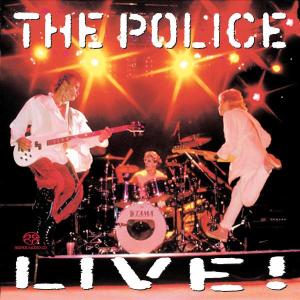
“Every Breath You Take”, “King Of Pain”, and “Wrapped Around Your Finger” were the soundtrack of the summer of ’83. Or at least that’s how it seemed in the northeast corner of America. Three songs about troubled relationships provided something an antidote for the music from
Flashdance otherwise stinking up the airwaves. And they all came from the pen of one man, who considered himself the face of The Police.
Stingy had a pretty strong hold on the band at this point, even considering his high-profile acting gigs, so it’s likely out of weariness to argue that that other two let him drive the direction of Synchronicity. A photo of him perusing the theory was prominent in the packaging, though even people who’d heard of Carl Jung before might have wondered what all the hubbub was.
A cycling synth and short phrases reels off “Synchronicity I”, which manages to rock despite a minimum of chord changes. “Walking In Your Footsteps” isn’t much more than a drum pattern with guitar effects and a basic melody about dinosaurs. The whole thing sounds pretty prehistoric. “O My God” at least sounds like a decent jam, with a reference to “Every Little Thing She Does Is Magic” at the fade. Despite its intricate backing, the awful vocal on “Mother” is guaranteed to clear any room anywhere within five miles, to the point where the deceptively short yet catchy “Miss Gradenko” sounds like the band of old. “Synchronicity II” matches a suburban nightmare with a mysterious beast signifying doom. It’s an excellent performance from the whole band, the drums and particular that buried guitar flourish on the fade offsetting Sting’s vocal.
“Every Breath You Take” follows a I-vi-IV-V sequence, proving once again that the simplest ideas will endure. And yes, it’s about stalking, and not at all romantic, but that melody is just so pure and so sweet, it’s no wonder this got to be so huge. “King Of Pain” takes a long time to get rolling; was it that important to repeat the entire first verse? And why does he pronounce “thing” like Ricky Ricardo would? Luckily the choruses provide relief, and the brief guitar solo mirrors the melody nicely. Bookended by another lengthy atmosphere, “Wrapped Around Your Finger” mines additional literary territory, with a cool, menacing lyrical twist at the end and another killer chorus. Those three songs are so strong that “Tea In The Sahara” seems barely there. Predominantly a bass-and-vocal song, if the other guys added anything, it’s mostly been mixed out except for Stewart’s hi-hat work.
Released with seemingly infinite artwork variations, Synchronicity was a huge hit, driven by a high-profile tour. (The warm-up act for seven dates? R.E.M.) It truly works as an album, with even the most jarring segments fitting within the flow. People who bought the cassette—or the CD, if they were early adopters—got a surprise ending in “Murder By Numbers”, a nicely macabre B-side that profoundly changes the album’s frame. It was certainly a long way from the punky trio of Outlandos d’Amour. Synchronicity showed how the band had truly developed. However, they’d had it with each other.
A year after its 40th anniversary, it became the first Police album to receive the deluxe expanded treatment. The basic double-CD included a remastered version of the album (including “Murder By Numbers”), which unfortunately made some of its once-cool sounds come off as dated, plus a second disc of B-sides and rarities. Most of these hadn’t been available for ages, including several live performances, a so-called “remix” of “Truth Hits Everybody”, the Sting-sung parody “Every Bomb You Make” from a Spitting Image TV episode, backing tracks for “Every Breath You Take” and “Roxanne”, and two odd remixes by Stewart Copeland. But for fans, the real meat is in the Super Deluxe Edition, which devotes two discs to demos and alternate versions of each of the album’s tracks, as well as tracks that didn’t make the album. Two more discs contain a live show from the tour, and different from the one that was already used for some of the aforementioned B-sides and sampled for 1995’s Live! double-disc.
The Police Synchronicity (1983)—3½
2024 Deluxe Edition: same as 1983, plus 18 extra tracks (Super Deluxe Edition adds another 55 tracks)





